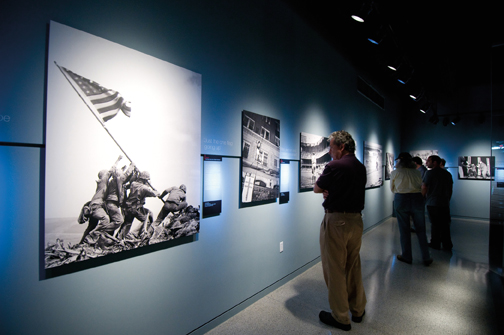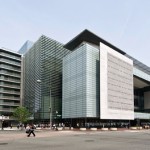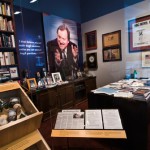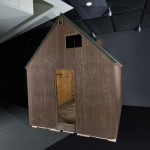Newseum — “…a museum devoted to news”
Posted on February 1, 2012 by bob in Travel

The Pulitzer Prize Photographs Gallery is filled with pictures that have burned themselves into the national consciousness. (Photo by Sam Kittner)
(by Andrea Gross; photos as credited)
One minute I’m standing in front of eight 4’ wide, 12’ tall sections of the Berlin Wall. A few minutes later, I’m watching videos of the moon landing, Princess Diana’s wedding, JFK’s assassination, 9/11…. As I walk through the Newseum, Washington DC’s 250,000-square-foot paean to journalism, I’m reminded of the old adage: Yesterday’s news is today’s history.

The Newseum complex, just blocks from the National Mall, is deserving of a banner headline. (Photo by James P. Blair/Newseum)
The museum, located on Pennsylvania Avenue just blocks from the National Mall, contains more than 35,000 newspapers, including one from 1718 that heralds the death of Blackbeard, the notorious British pirate, and one started by the brother of Benjamin Franklin. It’s filled with journalistically-relevant artifacts, like the microphone used by Edward R. Murrow for his radio broadcasts during the Blitz and the notebook used by the Newsweek reporter who broke the Monica Lewinsky story.
In addition, the Newseum houses hundreds of videos. A person could spend hours just watching videos—from an eight-minute overview of major events narrated by Charles Osgood to a 25-minute look at the history of sports reporting.
I hesitate before walking into the Comcast 9/11 Gallery. Do I really want to relive that horrible day? But of course I go in and sit spellbound as journalists who were there tell what they did to bring the story to the rest of us. The audience is transfixed; the room is completely silent. I feel as if I’m in a church.
All told, the Newseum houses 15 theaters and 14 main exhibits. My personal favorite is The Pulitzer Prize Gallery, a collection of photographs that deliver a gut-punch to the soul. There’s the horrified girl who saw her fellow student shot at Kent State, the napalm-burned child running down a street in Vietnam, the flag being raised on Iwo Jima. Video interviews with the photographers give the story behind the story.

A replica of Tim Russert’s office on the day of his death, on display through 2012. (Photo by Maria Bryk/Newseum)
In addition, there are a number of temporary exhibits that will only run until the end of this year. One of the most popular and poignant, “Inside Tim Russert’s Office,” shows the famous newsman’s desk arranged exactly as it was on the day of his death.
Another, titled “First Dogs,” features nearly two dozen pets that have provided our presidents with apolitical companionship. These include Coolidge’s white Collie, which was photographed wearing an Easter bonnet; George H. W. Bush’s English Springer Spaniel, which was credited with writing a bestselling book; and Warren Harding’s Airedale, which attended Cabinet meetings with his master. (One can only wonder what scandals would have been adverted if the dog had barked a few words of caution into the President’s ear.)

The Unibomber’s cabin is part of the new “G-men and Journalists” exhibit. (Photo by James P. Blair/Newseum)
On a more serious note, the “G-Men and Journalists” exhibit provides insight into the tension between law enforcement and the press, showing how the press prevents abuses of power but also makes the work of the special agents more difficult. More than 200 artifacts complement the photos and newspapers, including the cabin used by the Unibomber and the electric chair that ended the life of Bruno Hauptmann, who steadfastly denied that he was the person who kidnapped the Lindbergh baby.
Later, after a quick lunch in the Wolfgang Puck cafe on the lower level, I explore some of the interactive galleries, which are among the museum’s most popular. In one, reporter-wannabes try reading a news report from a Teleprompter and writing a story on deadline. In another, they confront ethical problems. When is it okay to quote anonymous sources? Is it more important to photograph a dying child who’s about to be eaten by a vulture, and thus alert the world to the plight of the Sudanese, or is it better to drop the camera and try to save the child?*
I wander out on the terrace, where a guide tells me that the Newseum was built on the site of the old National Hotel.
“That’s the hotel where John Wilkes Booth stayed when he plotted the murder of Abraham Lincoln,” he says. Inside I see the newspaper announcing the assassination of the president as well as ones telling of the hunt for Booth.
For contemporary events, there’s the broadcast studio where ABC News films its Sunday morning program, “This Week.” Behind the desk where George Stephanopoulos interviews the week’s newsmakers is the famous view of the capitol.
But even more interesting is the daily display of the front pages of 80 newspapers from across the United States and around the world, posted every morning at 6 a.m. Washington time. They are a stark reminder that while we in the United States may be absorbed with the presidential primaries, the people in New Zealand are focused on something else entirely. (www.newseum.org)
*Note: Faced with this dilemma, Kevin Carter opted to snap the award-winning photo. Afterwards he chased the vulture away, but haunted by the scene and by his own priorities, he committed suicide a few months later.









